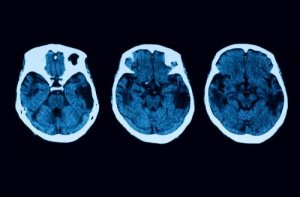Posterior Cortical Atrophy Diagnosis and Treatment

Posterior cortical atrophy is a neurodegenerative disorder that affects a person’s vision. People either lose it entirely or just partially. Loss of memory is also a symptom that’s often present. In today’s article, we’ll take a look at this disorder and show you how to identify it early.
Some studies point out that this disorder often isn’t diagnosed as early as it should. The reason is that because it causes visual symptoms, people often consult an ophthalmologist instead of a neurologist.
Because of this, we believe it’s important for you to be able to identify the symptoms that may be alerting you of the presence of posterior cortical atrophy. Let’s see some clues that you shouldn’t overlook.
The Phases of Posterior Cortical Atrophy

Medical studies reveal a series of phases of posterior cortical atrophy. Ideally, these symptoms should be discussed with a neurologist as soon as possible to initiate treatment as soon as possible.
- Gradual and slow onset of visual failure: A person may see shadows or lose vision entirely at times. The failure is so progressive and slow that it doesn’t attract attention until it gets much worse.
- Absence of ophthalmic pathology: If a person goes to an ophthalmologist, that doctor won’t be able to identify the condition that’s leading to the loss of vision. Therefore, the person afflicted with it will continue to live a normal life until their symptoms worsen.
- Small memory losses: As the disorder worsens, there’ll be a slight memory loss that some would consider normal. However, as the disease progresses, these memory lapses will increase.
- Beginning of dementia: A person with this condition will present hypometabolism and hypoperfusion that can be detected thanks to a test that involves a neuroimaging study. However, note that dementia arises when the disease is in fairly advanced.
Diagnosis
As you can see, the symptoms of posterior cortical atrophy are very slow but steadily progressive. Therefore, by the time a person goes to a neurologist, it could be too late.
So, if you notice changes in your vision added to a slight loss of memory then don’t hesitate to put yourself in the hands of a professional.
The first test to diagnose posterior cortical atrophy is a blood test. They’ll be able to detect vitamin deficiencies through it, among other findings. Afterward, a doctor will perform a more complete ophthalmologic exam.
However, diagnostic tests don’t end there. To clear any doubt, there’ll be other neurological tests such as MRIs and tomographies. If everything indicates that you might have posterior cortical atrophy, then there are different treatments you can opt for.
Treatment for Posterior Cortical Atrophy

Once you receive a positive diagnosis for posterior cortical atrophy, there are two possible treatments you can follow. However, note that neither one of them will cure the disorder. Thus, it’s a degenerative disease.
- The first treatment involves the use of medications to treat symptoms that may arise due to this disorder. The drugs reduce anxiety and improve depression if there’s any.
- A person can undergo cognitive therapy to preserve the skills that aren’t damaged and delay their loss. Also, they can undergo physiotherapy, it will help improve these circumstances.
These two treatment options mainly focus on improving the quality of life of a person and only treats their symptoms. The objective here is to delay the deterioration of their abilities and skills, thus improving the anxiety and depression that can come with this disease.
When in doubt, talk to your doctor
We wanted to make you’re aware of the symptoms surrounding posterior cortical atrophy ib this article. That way, you’ll be able to recognize the first symptoms and consult your doctor as soon as possible.
As we mentioned before, an early diagnosis will make a big difference. Don’t worry: There’s help for you.
All cited sources were thoroughly reviewed by our team to ensure their quality, reliability, currency, and validity. The bibliography of this article was considered reliable and of academic or scientific accuracy.
- Caixeta, Leonardo Ferreira, Taleb, Alexandre Chater, Ghini, Bruno Galafassi, Soares, Vânia Lúcia Dias, Caixeta, Victor de Melo, & Vargas, Ciro. (2013). Posterior cortical atrophy – a prototypical case of dementia beginning with visual symptoms: case report. Arquivos Brasileiros de Oftalmologia, 76(5), 314-316.
- Carvajal Castrillón, Julián, Aguirre, Daniel Camilo, & Lopera, Francisco. (2010). Perfil clínico y cognitivo de la atrofia cortical posterior y sus diferencias con la enfermedad de Alzheimer esporádica tardía y familiar precoz. Acta Neurológica Colombiana, 26(2), 75-86. Retrieved March 31, 2019, from http://www.scielo.org.co/scielo.php?script=sci_arttext&pid=S0120-87482010000200004&lng=en&tlng=es.
- Custodio, N., Alva-Diaz, C., Becerra-Becerra, Y., Montesinos, R., Lira, D., Herrera-Pérez, E., … & Valeriano-Lorenzo, E. (2016). Rendimiento en pruebas cognitivas breves, de adultos mayores con demencia en estadios avanzados, residentes de una comunidad urbana de Lima, Perú. Revista Peruana de Medicina Experimental y Salud Pública, 33, 662-669.
- Delgado D, Carolina, & Donoso S, Archibaldo. (2009). Atrofia cortical posterior. Revista médica de Chile, 137(11), 1482-1487. https://dx.doi.org/10.4067/S0034-98872009001100012
This text is provided for informational purposes only and does not replace consultation with a professional. If in doubt, consult your specialist.








